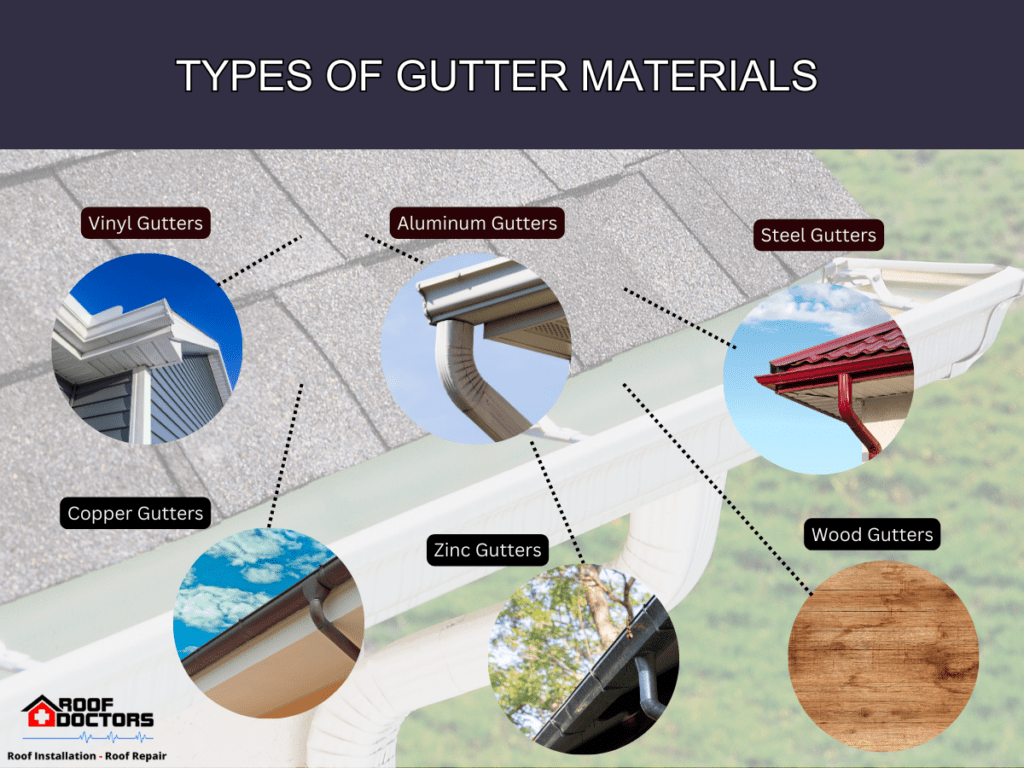Choosing the right gutter material for your home is an important decision that requires careful thought and understanding of the available options. This article will provide a comprehensive guide on how to choose the most suitable material for your home’s gutter system.
A functioning gutter system is a crucial feature of every home. It protects your home’s foundation, roof, siding, and landscaping from water damage. However, not all gutter materials are the same.
Importance of Gutters For Your Home
Before diving into the various types of gutter materials, it’s important to understand why gutters are essential for your home. Rainwater can lead to many problems, such as eroding soil around your home, damaging your home’s foundation, causing basement leaks, and deteriorating your home’s exterior.
A well-functioning gutter system channels rainwater away from your home, protecting its structural integrity. Rainwater can cause paint peeling, mold growth, and wood rot, leading to exterior deterioration of your home. It can lead to water stains on brick and stone masonry and damage to garage doors and windows.
By effectively channeling rainwater away from your home, a well-functioning gutter system provides a crucial layer of protection against these potential issues, helping maintain both the aesthetic and structural integrity of your home. Homeowners can choose the best gutter material for their needs by understanding its role and installation complexity.
Factors to Consider When Choosing a Gutter Material
When selecting the ideal gutter material for your home, several factors come into play. Here are the main considerations:

Climate
Your geographical location plays a key role in your choice of gutter material. If you live in an area that experiences heavy rainfall, you need a material that can handle large volumes of water.
For those in snowy regions, a sturdy gutter capable of withstanding the weight of snow is essential. Also, regions with drastic temperature changes require materials that can resist expansion and contraction, which can cause cracks and leaks.
Durability
The lifespan of the material is another crucial consideration. Investing in durable materials like copper and steel provides long-lasting protection against the elements, offsetting the higher initial expenses.
Aesthetic Appeal
Gutters are functional and contribute to your home’s exterior look. Therefore, you should select a material that complements your home’s style and color scheme. Some materials, such as copper, impart a distinctive touch of elegance but may not suit every architectural style.
Maintenance Requirements
Different materials come with varying maintenance needs. Vinyl and aluminum gutters may demand frequent cleaning and replacements, whereas copper and stainless steel are more resistant to deterioration.
Cost
Budget is a major deciding factor when choosing gutter material. Vinyl is usually the cheapest option, while copper and stainless steel are on the pricier end of the spectrum. However, considering the material’s longevity alongside its initial cost can give a more accurate picture of its overall value.
Installation Complexity
Some gutter materials are easier to install than others. While handy homeowners might be able to install vinyl or aluminum gutters themselves, other materials like copper or steel usually require professional installation, adding to the overall cost.
Installation complexity varies due to gutter design, roof architecture, and property requirements, affecting the overall cost and professional involvement.
Types of Gutter Materials
A wide range of gutter materials are available, each with unique characteristics that make them suitable for different climates, aesthetic preferences, and budgets. Below are some of the most common types of gutter materials:

Vinyl Gutters
Vinyl gutters are an affordable and popular choice for homeowners. They are lightweight, easy to install, and do not rust or corrode. However, they are less durable than other materials and can crack or warp in extreme temperatures, particularly in very cold climates.
Aluminum Gutters
Aluminum gutters are another cost-effective choice that is lightweight and resistant to rust. They can also be painted to match your home’s exterior. On the downside, they are not as sturdy as steel or copper gutters and can be prone to denting or damage from heavy winds or falling branches.
Steel Gutters
Known for their strength and durability, steel gutters can withstand extreme weather conditions better than vinyl or aluminum. Galvanized steel gutters, although more affordable, can rust over time. On the other hand, stainless steel gutters are rust-proof but more expensive.
Copper Gutters
Superior durability, copper gutters can last up to 50 years or more. They age to a beautiful patina over time, adding to the aesthetic appeal of your home. However, copper gutters are the most expensive option and require professional installation.
Zinc Gutters
Zinc gutters, similar to copper, are durable and long-lasting. They also develop a beautiful patina over time. They are less expensive than copper but still more costly than other options and also require professional installation.
Wood Gutters
Primarily used in restoration projects for historic homes, wood gutters can be expensive and require a high level of maintenance. They can offer a unique aesthetic appeal but are less common due to their cost and upkeep requirements.
You can make a well-informed decision on gutter material by considering advantages, disadvantages, your needs, aesthetics, and budget.
Bonus Tip:
We asked another roofer to give more depth to this article by providing an expert insight on seamless gutters. Here is what Dan Abelson with Roofs By Design said:
“Seamless gutters are an excellent addition to any home, providing both functional and aesthetic appeal.They have no joints or seams, which makes them less susceptible to leaks compared to their seamed counterparts.
Seamless gutters are primarily made from aluminum, but they can also be constructed from copper or factory-painted steel. Many people choose aluminum because it is lightweight, resists rust, and allows for painting in various colors to match the home’s exterior.Copper and steel seamless gutters, while more expensive, offer superior durability and longevity.
The greatest advantage of seamless gutters is the significantly lower chance of leaks. Joints and seams in a gutter system are typically the weak points where most problems arise. With their absence, the risk of water damage to your home is drastically reduced.
Installation of seamless gutters involves custom cutting and fitting to the exact dimensions of your home, ensuring a precise fit and providing a more streamlined look than traditional gutters. This process requires professional expertise to ensure proper fitting and performance.
While seamless gutters may cost more initially than seamed versions, their low maintenance and durability often result in lower long-term costs. Protecting your home from water damage and requiring fewer repairs, seamless gutters certainly justify the initial investment.
Keep in mind, every material has its pros and cons, and ultimately, the material chosen for seamless gutters should align with your climate, budget, and style preferences. These advanced gutters are gaining popularity for a reason, they not only protect your home effectively but also enhance its overall aesthetic appeal. So, when it’s time to install or replace gutters, consider going seamless!” Dan Ableson | Roofer in Raleigh, NC .
Maintenance Considerations by Gutter Material
Regardless of the gutter material you choose, regular maintenance is crucial for optimal performance. This includes cleaning out leaves and other debris that can clog your gutters, checking for leaks or cracks, and ensuring the downspouts are effectively directing water away from your home’s foundation. All of these tasks contribute to the longevity and effectiveness of your gutter system, as well as the overall health of your home.
However, it’s also important to note that some materials may require more maintenance than others. For example, aluminum and steel gutters may need repainting every few years to maintain their appearance and prevent rust.
On the other hand, materials like copper and zinc, while more expensive initially, develop a protective patina layer over time, which can reduce the need for maintenance.
Additionally, while gutter guards can help minimize debris accumulation, they don’t eliminate the need for routine cleaning. Even with guards in place, you should still check your gutters regularly for any potential issues. It’s always better to catch and address a small problem before it becomes a big one.
Gutter Installation
Gutter installation is a crucial aspect of maintaining the structural integrity of your home. An improperly installed gutter system can lead to water damage, erosion, and other costly repairs.
Below is a general overview of gutter installation; however, remember that the process can vary significantly depending on the material used and the specific layout of your home.
- Planning: The first step involves assessing the layout of your home to determine how many downspouts are needed and where they should be located. The general rule is to have a downspout for every 20 to 30 feet of gutter. The gutter system should be designed to channel water towards these downspouts.
- Measuring and Cutting: Measure the length of your house to determine how much gutter material is needed. This step also involves cutting the gutters to the appropriate length. Always measure twice to avoid errors.
- Mounting Gutters: Gutters are typically mounted to the fascia – the board running along the lower edge of the roof. Brackets or hangers are used to attach the gutters to the fascia. Ensure the gutters are slightly tilted towards the downspouts for efficient water flow.
- Installing Downspouts: Downspouts are installed at designated points along the gutter to direct water away from the house. These should lead the water at least five feet away from the house to prevent foundation damage.
- Sealing Joints: Lastly, all joints and seams need to be sealed to prevent leaks. This step is crucial for maintaining the efficiency of your gutter system.
While DIY installation might be possible for simpler systems like vinyl or aluminum, it’s generally recommended to hire professionals for the installation of more complex materials such as copper or steel gutters. This is because installing these materials correctly requires specific tools and expertise, which can prevent potential leaks and ensure optimal water flow.
It’s also important to remember that safety should be your top priority. If you’re uncomfortable with heights or don’t have the proper safety equipment, it’s always best to hire a professional. Additionally, hiring a professional will usually come with the benefit of a warranty for the installation, giving you peace of mind and protecting your investment.
Conclusion
Choosing the right gutter material for your home is a decision that requires a careful analysis of the pros and cons of each option. Factors such as your local climate, your home’s architectural style, budget, and maintenance preferences should guide your selection.
Remember that while the initial cost of the gutter system is important, the longevity and durability of the material should also factor into your decision. Regular maintenance and professional installation can go a long way in ensuring your gutters protect your home from water damage for many years to come.


